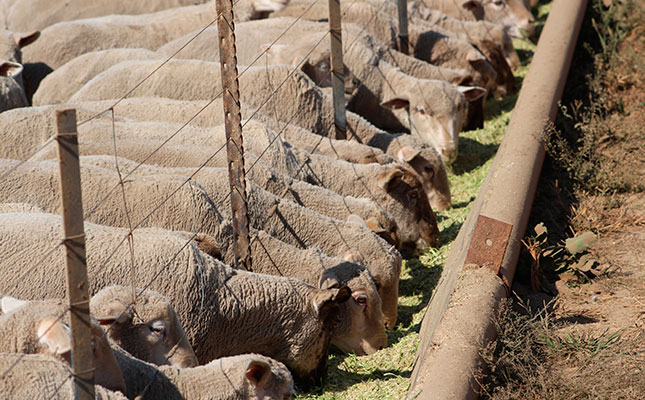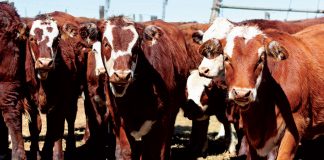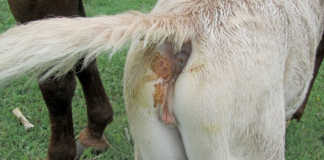
Photo: By FW Archive
Abortion, which can occur at any stage of gestation, is the result of a disturbance in the functioning of the afterbirth (placenta). This causes premature loss of the foetus.
Many conditions can cause abortion in sheep and goats.
The most frequent are the infectious types: enzootic abortion, brucellosis, Rift Valley fever and Wesselsbron disease. This week, we’ll look at the first two.
Enzootic abortion
Enzootic abortion (chlamydiosis) is a contagious disease in sheep and goats caused by Chlamydophila abortus (previously Chlamydia psittaci).
It can even induce abortions in pregnant women who handle sick sheep or lambs.
The disease is usually spread during lambing.
Livestock also pick up the bacteria by mouth when grazing an area contaminated by infected afterbirth or uterine fluid.
The infection can remain dormant in the ewe lamb until its first pregnancy. An outbreak invariably occurs within a year or two of infected sheep arriving on the farm.
The more intensive the sheep-farming enterprise, the more likely it is that the disease will spread.
An infected ewe will not appear ill; blood spots above the udder and on the hocks may be the only signs of abortion.
A newly-infected flock may have an abortion rate of up to 70%. Abortion can occur as early as three months, in which case the foetus is usually resorbed, or as late as the last month of pregnancy.
The ewe may even give birth to a small, weak lamb that dies shortly after birth.
Treatment and prevention
Treatment involves a prolonged, high dose of antibiotics, but this is seldom practical or affordable.
Onderstepoort Biological Products (OBP) produces an oil-based, inactivated vaccine to prevent abortion caused by chlamydial infection.Pregnant ewes can be safely inoculated.
It is essential to vaccinate before the breeding season, as the vaccine will not provide protection against abortion once the foetus has been infected.
The ideal time is four to six weeks beforehand.
Brucellosis
This is caused by the bacterium Brucella melitensis.
A high percentage of the infected ewes will abort, and infected humans develop Malta fever, a disease characterised by fever, joint pain, headaches and sweating.
Lambs may be born alive, but die soon afterwards. Such lambs, as well as foetal fluid and afterbirth of the infected ewes, contaminate the grazing, spreading the disease further.
The bacteria also contaminate the milk of the infected ewe, and the animal may show symptoms of mastitis.
She may not look especially ill, but will appear weak and in poor condition. After the abortion, she will discharge a thick, dark-red fluid from the vulva.
Treatment and prevention
Vaccination is an option in countries where there is a high incidence of the disease.
In South Africa, however, vaccination is not permitted; instead, the authorities aim to eradicate brucellosis by destroying all infected animals and removing all traces of infected material from the lambing area.
READ Vaccinate your livestock!
A sheep or goat farmer should report abortions to the nearest state vet or animal health technician, who will assist in controlling the disease.
Wesselsbron disease
This was first identified in the Free State’s Wesselsbron district in sheep that aborted after having been vaccinated against RVF.
Wesselsbron is a viral disease transmitted by mosquitoes. It affects mainly sheep and goats, causing abortions in gestating animals, or the death of young lambs. Humans may contract the disease after handling infected carcasses.
Often, the only symptom of a Wesselsbron abortion is a mild temperature. The ewe aborts because the foetus has died. Up to 30% of infected lambs die, usually between one and 10 days after birth.
Prevention
At this stage, no preventive vaccine is available. For further information, contact your nearest animal health technician or vet.
Rift Valley Fever
This is caused by a virus transmitted by mosquitoes after heavy summer rainfall; it is typically spread along river courses. Infected animals can transmit the disease to others by means of aborted foetuses. RVF is also spread by needles during vaccinations, and this can lead to a mortality rate as high as 95% amongst young lambs.
RVF, like Wesselsbron disease, is also a zoonosis; humans can contract the disease after handling sick animals or aborted foetuses.
The incubation phase is very short; lambs normally show symptoms within one to three days of becoming infected. But some die 12 to 24 hours after being infected without showing any signs.
Newborn lambs and goats are prime targets.
RVF can lead to an abortion storm in the flock. Adult sheep may be weak, have bloody scours, and bleed from the nose.
Prevention
Onderstepoort Biological Products (OBP) manufactures two RVF vaccines. The first is a live vaccine for sheep and goats, and a single dose provides long-lasting protection. However, this vaccine cannot be used on gestating animals as it can cause abortions.
The live vaccine also affects brain tissue; if an in-lamb ewe is vaccinated before the foetus is three months old, the vaccine attacks the undeveloped brain of the lamb and causes malformation.
Lambs and kids of vaccinated sheep and goats should be vaccinated at six months or at weaning, but not before, or their natural immunity will be destroyed.
The second OBP vaccine is an inactivated vaccine developed for gestating sheep and goats. Immunity lasts for a year at most.
For further information, contact your nearest animal health technician or veterinarian.
Source: Mohale, D. 2013.
Abortions and causes of death in newborn sheep and goats. Directorate of Communication Services in cooperation with ARC-Onderstepoort Veterinary Institute. Department of Agriculture, Forestry and Fisheries.











